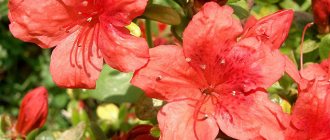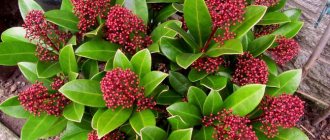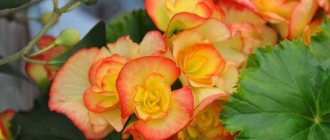Azalea: description, photo
Azalea is called “rose tree”, “alpine rose”, “rose bush”. This is due to external characteristics. From a distance or in photographs, dwarf bushes are often mistaken for thickets of wild roses. The flower stems are covered with light gray bark, which may be partially lignified. The bush grows up to 1.5 m, but as a houseplant it stretches up to 50 or 60 cm. The leaves can take a semi-oval or oval shape, grow up to 3 cm, be light or dark green, and slight fluff can be noticeable on the underside of the leaf blades.
The type of flowers depends on the varietal characteristics: small flowers grow up to 2 cm, large ones up to 5-6 cm. As a rule, they are collected in complex inflorescences that begin to appear at the base of the leaf. The shade of the petals can be very different, ranging from monochromatic, evenly covered, to multi-colored with different shades.
The appearance of azaleas is associated with the regions of India and China. There, in areas of the foothills, flowers were discovered and described by scientists. The genus of these alpine roses received its own name, azalea, but over time it was disbanded, and they began to be classified as rhododendron.
The species began to develop and became widespread. More than 10 thousand varieties were created through selection. Now rhododendrons decorate residential buildings around the world. Caring for azaleas at home is simple, but the rules may differ significantly from the requirements of other flower crops. Indoor flowers are represented by two types, which number thousands of varieties.
| Indian or Sims rhododendron | Japanese view |
| A low bush, stretches up to 70 cm, the branches are densely located on both sides of the stem. The bottom plates may appear several shades lighter than the top plates. Indian azaleas have buds that grow one at a time and can grow up to 8 cm in diameter. Shades of petals can be pink, burgundy, cream. This variety has a particularly long flowering period. | Azaleas of these varieties are pruned for bonsai-type cultivation. A cap of small flowers on a bare stem often becomes the center of flower arrangements. Hybrids stretch up to 1 m; regular pinching is recommended for them. |
The flowering of the azalea (rhododendron) in winter has made it popular since the 19th century. In modern Europe, pots with them still remain a symbol of the Christmas table; they are presented at housewarming parties as a wish for a long and happy life.
Types and varieties
Numerous varieties and varieties of the following types of azaleas are grown indoors:
- Simps's rhododendron, or Simps's azalea, or Indian azalea, is a hybrid plant with a rich history;
- rhododendron obtuse, or Japanese azalea.
Both of these species are dwarf shrubs with a height of 30 to 50 cm. Varieties and hybrids of azaleas according to flowering periods are divided into early flowering, the flowering of which continues from late October to early January, mid-flowering (from January to March) and late flowering (from January to early May ).
The most popular early flowering azaleas are:
- Adventglockchen - a variety with bell-shaped simple or slightly double crimson-red flowers up to 6 cm in diameter;
- Dresden 1936 - shiny medium-double flowers of a salmon-pink hue;
- Doberlug - double dark pink flowers up to 7 cm in diameter with a white border of irregular outline;
- Weiss Shame - wide funnel-shaped double flowers with a diameter of 6.5 cm, white with a cream or soft pink tint;
- Eri - semi-double carmine-pink flowers with a diameter of about 7 cm with a white border of irregular shape;
- Orange Bowen - semi-double raspberry-red flowers with a diameter of 5 to 6.5 cm;
- Enzette Dagmar - shiny double flowers up to 7 cm in diameter, intense pink;
- Helmut Vogel is a very early variety of azalea with double purple-red flowers with a diameter of 7 cm.
Medium-flowering azaleas are represented by the following popular varieties:
- Albert-Elizabeth - white or soft pink double flowers up to 8.5 cm in diameter with a red border along the edges of the petals;
- Apollo - simple and slightly double flowers, slightly wavy along the edges of the petals, brick-red flowers with a diameter of 7 cm;
- Avenir - semi-double, bright salmon-carmine flowers up to 8 cm in diameter with an intense carmine tint in the folds of the petals;
- Florida - simple dark red flowers up to 6 cm in diameter;
- Leopold Astrid - double flowers of soft pink color with a diameter of 7 cm with a red border and petals corrugated at the edges;
- Max Shame - double, salmon-colored flowers with heavily corrugated petals, up to 6.5 cm in diameter, with a white border along the edge.
Of the azaleas that bloom later than other varieties, the following are popular:
- Niobe - double white flowers up to 7.5 cm in diameter with a greenish throat and red specks on the petals;
- Concinna is a vigorous variety with simple funnel-shaped light lilac flowers up to 7 cm in diameter with bright crimson specks;
- Ernest Tirs - semi-double raspberry-pink flowers with a diameter of about 8 cm;
- Coelestinum - simple intense carmine flowers with a diameter of 6 cm;
- Hexe is a vigorous variety with double flowers of a bright wine color;
- Professor Walters - simple funnel-shaped flowers of a bright light salmon hue, up to 7.5 cm in diameter with almost white edges, the three upper petals are decorated in the throat with crimson-red specks;
- Sakuntala - white double flowers up to 7.5 cm in diameter with green specks in the throat.
You can divide azalea varieties by color. For example, varieties with white flowers, in addition to those that we have already described, include Mary, Heidi, Watercolor, Snezhinka, Shneg, Rose Belton. Azaleas with red flowers: Simon, Holland, Knut Even, Eclair, Ilona, Frau Elsa Kärgeri. Raspberry flowers are found in the Cosmos variety, lilac flowers in the Flamenco, Violyacea multiflora, Ostalette and Temperance varieties, and pink flowers in the Terra Nova, Pink Pearl, Oslo, Scarlet Flower, Rays, St. Valentine and Rosalie azaleas.
Azalea flowering at home
Features of the culture are the duration and timing of flowering. It occurs depending on the variety and lasts 2-3 months if you properly care for the plant. In addition, under certain conditions, re-blooming occurs. The flowering of indoor azaleas of early varieties lasts from November to January. Late varieties bloom in January-February. If no maintenance conditions were violated, then the indoor azalea will bloom for 2 to 3 months. For abundant flowering, certain rules are followed.
Placement
Alpine roses love light; it should reach the leaves for 10 hours. Flower growers place pots on windows on the southeast side. In addition, the possibility of shading is taken into account so that direct sunlight does not fall on the platinum sheets and does not burn them. In order for buds to form on the stems, the azalea is additionally illuminated using artificial light.
azalea flowering at home
Watering
This is a special care point. Flower growers recommend monitoring the balance of soil moisture. It should be moistened, but not soggy. The soil is watered as the top layer dries. Excessive watering and stagnation of water on the tray lead to damage to the root system - the plant loses its ability to absorb moisture and becomes defenseless to fungal diseases.
Air temperature
Azalea is a crop that begins to bloom when the air temperature drops. To stimulate bud setting, the pot is taken to a place where the thermometer remains at + 15 to + 17°. Some varieties begin to bloom at + 10°. When the plant has gained color, it will be comfortable at + 23°.
Soil characteristics
This crop blooms in acidic soil. Experienced gardeners use heather soil for planting. This is a layer of earth, the upper part of which is at the stage of natural decay. Heather soil is collected in areas where heather bushes grow. The acidity level of such soil is in the range from 4 to 4.5 pH.
Capacity
Pots with a narrow base and a wide top are suitable for azaleas. This is due to the structural features. The roots do not grow deep, they need more space at the base, and the bottom of the planting pot must be well drained.
Fertilizer application
Botanists have developed a special feeding scheme. The soil is fed twice during the entire flowering period of the azalea. During the summer, fertilizer is applied once every 2 weeks.
What is an indoor azalea
The plant belongs to Rhododendrons - “pink trees”, because they bloom profusely with bright pink or red flowers. The branching azalea bush grows slowly, an adult plant is no higher than 50 cm. The shoots are covered with small glossy leaves, which are so few that they are not visible under the flower caps.
Azalea blooms most often in February, but sometimes in autumn. It blooms most profusely in the 3rd year of life, and proper pruning only increases this amount. Simple or double flowers covering the plant look like red, white, pink or purple funnels up to 7 cm in diameter. Thanks to breeders, azaleas with two-colored and variegated petals have already appeared.
In addition to its beauty, the plant is useful in that it purifies the air in the room from xylene, ammonia and formaldehyde. But the beauty of the azalea is not harmless: if the juice or parts of the plant enter the human or animal body, it will result in severe poisoning.
General principles of care:
- Do not place the plant in direct sunlight.
- Air humidity must be high.
- Watch the soil, it should not dry out or become waterlogged.
- Periodically acidify water for irrigation.
- It is forbidden to loosen the soil as the plant has thin roots.
- Maintain a constant air temperature - about 12-19 degrees.
- For flowering, it is necessary to pinch the stems correctly and in time.
How many times a year does azalea bloom?
Azalea is an indoor flower that is characterized by slow development during the first years of its existence. Many inexperienced gardeners mistake this feature for a manifestation of illness or dissatisfaction with care. They begin to rearrange the pot, treat the stems with different chemicals, or even try replanting. This is unnecessary trouble. The alpine rose takes a long time to get used to the new environment and begins to bloom only after 2-4 years of existence.
A houseplant can be seen blooming twice if it is planted in open ground areas in the summer. In this case, it is necessary to carefully select a place for planting and prepare special acidic soil.
Information! After planting in open ground, the azalea is cared for in the same way as a houseplant. In autumn they are transplanted into a pot.
How to grow from seeds?
Some gardeners decide to get the plant from seeds. This is a rather long method, but it is also used periodically. Here's what you need to do:
- Buy seeds at a specialty store. You won’t be able to get them yourself, because the flower will not be pollinated.
- Prepare a container for planting and pour drainage into it, as well as substrate 1–2 cm below the level of the container.
- Disinfect the soil.
- Spread the seeds so that there is a distance of about 1.5 cm between them.
- Spray them with a spray bottle.
- Cover the container with polyethylene, creating ideal conditions.
Important. There is no need to cover them with soil. They will sprout roots and take root in the soil.
How to make azaleas bloom longer
Collectors of this variety have long and successfully stimulated the setting of buds. When they talk about the appearance of flowers over 2 months, they mean the gradual death of some inflorescences or buds and the systematic formation of new ones. If you make no attempts to prolong the process, it will last up to 2 weeks. With constant monitoring of the process, budding will only end in 2 months.
After flowering, each bud is carefully removed, this allows the plant to concentrate its energy on the formation of the next bud. Proper pruning is also necessary for abundant flowering. It is carried out at the resting stage, when the main part has faded.
Diseases and pests
Diseases of azaleas are most often associated with violation of the rules of care and maintenance: too high a temperature in the room, poor lighting, insufficient or excessive watering, planting in soil of inappropriate composition. There may, of course, be other reasons.
- Croton (Codiaeum) – care, photos, types
A lack of moisture in the soil and air can be indicated by limp, wrinkled or falling leaves and buds of the azalea. Correct your mistakes and keep in mind for the future that when the air temperature rises, watering should be more abundant and more frequent, and when the temperature drops, the amount of moisture should be reduced. Watering with hard water also harms the plant: tap water needs to sit for at least two days, otherwise the leaves begin to turn yellow and fall off, and the flowering of the azalea becomes sparse.
Poor light and direct sunlight also harm the plant, so try to find a suitable place for your azalea. The health of the flower is affected by the composition of the soil that does not meet its needs: the substrate for azaleas should be acidic, not neutral, and certainly not alkaline.
Azalea is very resistant to pests, but in conditions of insufficient watering and dry air it can be occupied by spider mites, which make small punctures on the leaves of the plant and suck out cell sap. If you find discolored spots and fine cobwebs on the foliage, immediately wash the azalea leaves on all sides with a weak tobacco solution with the addition of liquid detergent. Remember to protect the soil in the pot from alkali. 2-3 hours after treatment, azalea leaves should be washed well with clean cold water.
Effective against mites pollinating azaleas with sulfur powder or treatment with acaricidal preparations - Actellik, Aktara, Karbofos. Both pollination and spraying should be carried out outside the apartment, preferably in the open air, and as many times as needed to destroy pests. The interval between treatments is from 7 to 10 days.
Azalea after flowering care
Late varieties stop setting buds by April, early varieties enter the resting stage in January or February. After flowering, a crucial period of care begins; it plays a key role in the further development of the flower.
How to prune after flowering
Pruning rhododendrons is one of the most important principles of care. A plant that is not pruned at the right time will not be able to adapt to the summer season and form flower buds for the next flowering. Pruning is a solution to several problems at the same time:
- An adult bush is forming.
- Further flowering is stimulated.
- There is a growth of new shoots and renewal.
Pruning is carried out with sharp garden pruners, trying to cut at an acute angle. The following are subject to removal:
- old, damaged branches;
- non-viable shoots;
- dead inflorescences;
- dried parts.
Pruning is different from pinching, which is done on an ongoing basis. By pinching in summer, the skeleton of the bush is formed, preventing its all-round growth. Pinch out the top shoots, side shoots, and axillary leaves.
Replanting after flowering
Young rhododendrons are replanted every year. Mature bushes change their place of growth every 2-3 years. Planned replanting is carried out after complete flowering. Replanting may be necessary if the soil is partially changed, the root system begins to rot, or the aerial parts become diseased. Reproduction is also associated with transplants. Dividing a bush is a method of breeding while preserving varietal characteristics. The mother plant is dug up, divided and planted separately.
Flowering plants are replanted only as a last resort; planned replanting requires preparation. After the buds die, pruning is carried out, removing dead parts, then containers and soil mixtures are prepared. Pots are selected taking into account the changes; the selected container should be 2-3 cm larger than the previous one. The soil is shed in advance with a manganese solution; this method helps to avoid infection with fungal diseases after transplantation, when the rhododendron is too weak to resist on its own.
The transplant is carried out in the evening. Throughout the day, the pot is placed in a large container with water diluted with root biostimulants. Thanks to the pot's drainage system, the soil becomes soggy. After this, the roots are taken out along with a lump of earth and immediately transferred to the bottom of the prepared hole. The roots are not straightened or cut off unnecessarily. Pruning and disinfection are carried out only when the rhododendron is sick. For healthy home flowers, the method of transshipment is suitable, that is, replanting along with a lump of earth.
A hole is a small hole with a distance of no more than 1 cm from the drainage layer. After transferring, the voids are filled with prepared soil, the surface is patted down, watered and the azalea is removed for adaptation on a shaded windowsill.
Azalea's dormant period
Dormancy for an indoor flower occurs after transplantation; it lasts from May-June to November-December. Typically, flower crops are left untouched throughout the sleep phase, but this does not apply to rhododendrons. The rest period is used to apply regular fertilizing. Mineral complexes with a high content of phosphorus, nitrogen and potassium are suitable for this. Fertilizing is applied at the root weekly.
Special complexes that are created for this species are used at different stages of development:
- Before flowering, Zircon is added. It stimulates budding and development of the root system.
- Foliar feeding is carried out with Epin solution. It cannot be used during active growth or budding.
- With active development and establishment of shoots earlier than planned, Ferovit is applied. This remedy is rich in iron and can stop the start of exiting the resting phase too early.
Warning! When dissolving special complexes, carefully monitor the concentration. An excess of base substance can burn the roots.
Growing problems
Often, when keeping flowering indoor plants, processes occur that indicate a violation of the rules of care or the progression of diseases.
What to do if an azalea drops its leaves
Partial or complete shedding of leaf blades by rhododendrons signals problems. Based on the accompanying symptoms, the main causes of the phenomenon can be identified:
- Brown spots form on the leaf blades, the buds dry out, and the rhododendron sheds its leaves - this is a consequence of possible rotting of the roots and excessive dampness of the soil.
- A complete reset is evidence of lack of space, changes in soil composition, and lack of nutrients.
- Brown spots and dry areas appear on the tips of the leaf blades - this indicates a violation of watering requirements, indicates the flower is drying out or watering with cold, hard water.
- Leaves dry out and fall off - this is a sign that the air around the azalea is too dry.
Once the root cause is determined, appropriate measures are taken. If the azalea has dropped its leaves due to overwatering, then it is dried. One of the methods is to pull out the flower, dry the roots on a dry piece of cloth and add fresh dry soil. You can transplant the azalea into a new container or leave the old one.
If the alpine rose is partially dry, create conditions for moisture. To do this, they constantly spray the air near the flower, place containers filled with water around the perimeter of the window sill, and reduce the heating of the room. It is recommended to change the water used to water the soil to rainwater or to water the soil with melted snow. If after changing the water the shedding of leaves slows down, then the cause of the phenomenon is excessive hardness. Care continues with settled water.
Advice! To soften tap water, add citric acid or lemon juice.
Causes of yellowing leaves
Yellowing of leaves is one of the signs of the development of possible diseases:
- Chlorosis. This is damage to the root system due to an excess of potassium. It begins with a gradual yellowing of the leaf blades, accompanied by a loss of elasticity of the main and lateral stems. To reduce the indicators, the soil is carefully acidified.
- The appearance of pests. Scale insects can cause yellow areas to appear on leaf blades. They stick to the lower part of the leaves, cover parts of the plant with a sticky secretion and systematically destroy the stems. They can be removed by treating with soapy water or special chemicals.
Causes of blackening of leaves
Darkening of areas and gradual death may indicate various external influences.
The appearance of black thrips. This is a small pest that cannot be noticed immediately. It lives on the lower part, and blackening forms in places where it accumulates. In order to get rid of it, the plant is treated with a solution of copper sulfate. This method may result in reduced growth rates, but will get rid of the parasite.
Fusarium. A fungal disease that can only be cured at an early stage. It is characterized by blackening of the stem and leaves. The plant is treated with a solution of Fundazol. The plant, blackened to the top, is destroyed.
Rhododendron mite. An insect that can destroy a crop. Black spots cover all parts of the flower. The insect is dangerous because it quickly lays eggs. It is destroyed by stage-by-stage chemical treatments.
Preparing the soil for azaleas
Indoor azalea grows in loose, permeable and acidic soil with a pH no higher than 4.5. Ready-made substrates “For azaleas” are offered by gardening stores, but making a soil mixture is not difficult at home. It can be planted in a 2:1 mixture of coniferous peat, adding a little river sand. If you are going to buy soil in a store, then opt for acidophilic soil for plants, that is, acid-loving.
Soil recipes for azaleas:
- Take 1 part each of moss and sand, add 2 parts of rotted pine needles.
- Mix with 2 parts of leaf soil:
- 2 parts of pine humus;
- 1 part each of heather soil, sand, high-moor and low-lying peat.
The soil from the garden needs to be acidified with lemon juice or citric acid, adding to the water when watering: for 10 liters of water - half a teaspoon of juice. If you take citric acid - a pinch per liter of water.











